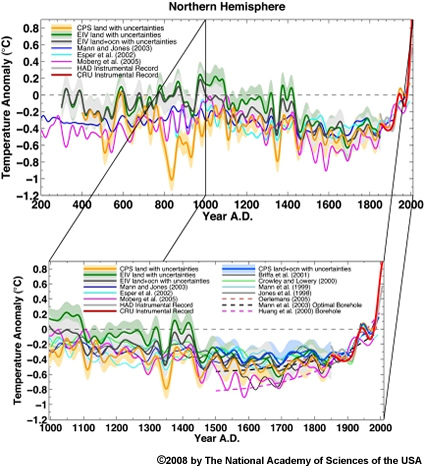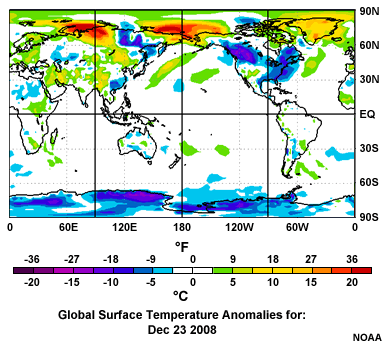FAQ
FAQs by Section
FAQ - What Changes Climate?
No. Warming in the first half of the 20th century did happen at the same time as increased solar activity. But that hasn’t been the case with the second half. Based on the sun’s output, we would have expected little or no change.
No. In 2008 the National Academy of Sciences published a new paper (see Take Aways and References) by Michael Mann et al. on proxy-based temperature reconstructions. This paper addressed suggestions made in 2006 by a National Research Council study, using a much larger set of data and analysis methods that were validated with model experiments. It confirmed the likelihood that the recently observed temperature increases in the Northern Hemisphere are unusual for at least the last 1,300 years.

FAQ - Is It Real?
There is a lot of natural variability on interannual and decadal time scales. Given this, the question is, "How large is the change due to human activities relative to the natural variability on the same time scales." Scientists sort this out by running climate models many times and seeing what part matches observations in all cases and is therefore tied to the changes due to human activities. The natural variability, from weather or El Niño for example, varies from one model run to the next. It is important that climate models have realistic levels of natural variability, and some models are now reproducing the El Niño-Southern Oscillation quite realistically.
No. Cities do produce heat that can affect temperature measurements, but climate scientists take great pains to remove the urban heat island effect from their data. It's well known that cities produce their own heat islands from the combination of concrete surfaces, less vegetation, reduced soil moisture, and exhaust from machines and cars. But scientists take this into account when assembling a data set. A NASA group removed 80% of their U.S. reporting stations from the global average based on night-time light production, leaving 200 true rural sites-still plenty-from their data. The warming pattern persisted.
Second, a U.S. National Climatic Data Center study found that from 1880 to 1998, the rural subset of their 7,500-station global record warmed slightly faster than the full record. The same study found no statistically significant urban heat island effect in 289 U.S. stations.
And finally, even though there are no cities in the oceans, warming has been measured over them too.
A climate feedback is an amplified or dampened response to an initial change in the climate system. For example, a self-reinforcing feedback (or "positive" feedback) occurs when warmer temperatures melt sea ice. The darker open water no longer reflects radiation as the ice did, but instead absorbs heat, increasing the melting, which leads to more warming, and so on. On the other hand a negative feedback would decrease warming. For example, increasing clouds in a warmer climate could cool the climate by reflecting incoming radiation. (However, clouds could also add as a positive feedback by trapping heat.) While there are a lot of uncertainties related to feedbacks from clouds and other processes, there are no negative feedbacks that we can look to with confidence to erase warming, whereas several positive feedbacks such as ice melting are expected to make warming worse.
FAQ - How Do We Know?
IPCC procedures state that if a consensus is not reached, "differing views shall be explained and, upon request, recorded." All comments made during the process are listed and their resolution noted. For example, you can go to the Harvard Environmental Science and Public Policy Archives (click Take Aways and References for a link) and see all the comments and responses on the first and second drafts of the Working Group I Fourth Assessment Report. Of course, this doesn’t mean that every scientist is entirely satisfied with everything in the final document. However, it does mean that the IPCC process is open. More about dissenting positions is discussed in the section, "How Sure Are Scientists?"
Of the IPCC reports, only the Summary for Policymakers receives a word-by-word review by international diplomats. The lead scientific authors of the report are present to ensure that any changes are scientifically valid. The diplomats have a say in how the summary is worded, but the scientists have the last word on what is said.
No. Climate models aren’t fit to a particular trend in temperature. However, some climate processes are represented by approximations (called parameterizations), and those formulas may be fit to best match observed data. There are actually only a few of these that are adjusted, and once they are set, the model results are not constrained to fit observations or expected results.
Regional climate models look at just a small area of the globe, but at higher spatial resolutions. They do this by creating many smaller grid boxes within part of the larger global grid. This higher resolution can capture more of the terrain details that greatly influence local climates. However, this also greatly increases the number of calculations. To keep the computations to a manageable level, the models are run for a limited area, such as the Arctic, the U.S., or New England.
Regional models are improving and can currently provide realistic simulations of smaller features like hurricanes that the global climate models can’t. However right now, the models can only make general projections about average temperature and precipitation patterns, especially where the grid sizes are still too large to adequately depict local complex terrain.
FAQ - Why Should We Care?
Scientists have been concerned that meltwater from Greenland could decrease the salinity of North Atlantic seawater enough to shut off the thermohaline circulation system that warms Europe and powers the Gulf Stream. However, the latest studies indicate that this is probably not as great of a threat as was once feared, at least in this century.
Change does not always happen gradually. Tipping points are large, sudden-onset, long-term consequences that result from an apparently small change. An example would be tilting a table until the items on top suddenly slide off. Climate scientists are concerned that the gradual increase of carbon dioxide may trigger tipping points in natural systems that will be dangerous, expensive, and may be impossible to reverse in the short-term. These kinds of tipping points include the dieback of the Amazon rainforest and the melting of the Greenland ice sheet. These changes could trigger other consequences that might include:
- Collapse of the Indian Summer Monsoon
- Dieback of the boreal conifer forest
- The greening of the Sahara/Sahel in Africa (an unusual example of a beneficial potential tipping element)
No. Climate change is superimposed on underlying natural variability. There have always been cold snaps and heat waves, and they will continue within the context of higher overall temperatures. The global average temperature may be cooler from one year to the next due to this natural variability. Other natural indicators such as sea-level rise and glacier loss tell us that long-term change is unfolding even in months or years that seem relatively cool. What’s most important is the pattern we see over large areas and long time periods, not what’s happening in a particular place on a particular day. For example, compare these two graphics:

Tuesday, Dec. 23, 2008: Notice the cold snap in the eastern third of the U.S. and western Canada.

Annual Anomalies (Feb. 2008-Feb. 2009): The larger warming trend becomes apparent in the annual data.
FAQ - How Sure Are Scientists?
One of the biggest uncertainties is clouds: some clouds act to cool the climate, while others have a net warming effect, and we don’t yet know how our present mix of clouds will evolve. It’s important to keep in mind that uncertainties like these aren’t necessarily an escape hatch. They could help counteract climate change, or they could help make it even worse. Another source of uncertainty is the many subtle interactions between plants, soil, sea creatures, and other climate components that we don’t understand and therefore can’t take into account. Another wild card is the contribution of melting and disintegrating ice to climate change, which is currently not well represented in models. However, looking at how the climate actually reacted under similar circumstances in the past gives us confidence that even though we may not understand all the details, we have the general idea of what will happen. Other uncertainties are such things as the rate of future economic development, how long it will take to switch to alternative energy sources, or whether future technology will enable us to remove the CO2 in the atmosphere.
Yes, science always has to leave room for unknowns. But since the models based on the factors we do understand can replicate the actual outcome of past climates, it seems scientists have a good grasp of the essential elements. Further work on the unknowns will probably help refine the results, not drastically change them.
Scientists did find that the Earth cooled slightly from the end of World War II until the 1970s, and some suggested that a "snow blitz" could accelerate the cooling and bring on the next ice age. However, the majority of the scientific community was not part of the global cooling buzz of the 70s. The peer-reviewed literature had many more articles about the planet’s potential to warm due to the effects of CO2. The possibility of an ice age was more attractive to the media, so the cooling theory briefly received more press. As it turns out, sooty pollution from post-war factories blocked sunlight like volcanic particles, and along with possible changes in ocean currents, probably caused the short-lived cooling trend.
Other evidence besides that from climate models leads us to believe that warming is likely to continue. The well-established physics and chemistry of carbon dioxide, our measurements of past climate change, and the signs of change in the environment all supplement the evidence from models and give us confidence that we should take action. However, there is a lot of debate about what those actions should be. Those are largely policy questions, not scientific ones.
FAQ - What's Next?
Geoengineering—the deliberate modification of the environment on a large scale—is an important strategy to consider, but many of its forms are last resort alternatives. Some forms of geoengineering, like carbon sequestration, are probably going to be important parts of the solution. Carbon sequestration involves injecting carbon dioxide into rock layers deep underneath the Earth’s surface, in some cases into the very same fossil fuel reservoirs we got the carbon from in the first place. On the more farfetched side are schemes such as blocking sunlight by deploying millions of small mirrors into space or releasing sulfate particles to replicate the cooling effects of a volcanic eruption. Some of these seem wildly impractical, and don’t get at the root causes of climate change. And they could have unintended consequences that produce disastrous effects. On top of all of this is the ethical question of who decides for all humanity to deliberately change the climate.
In the short term, a recession can reduce emissions by curtailing economic activity. U.S. carbon dioxide emissions went down in both 1991 and 2001 due to economic slowdowns. However, emissions returned to previous levels once the economy picked up, and atmospheric CO2 concentrations continued rising. Improvements in energy efficiency that require a one-time startup cost (such as installing solar panels) may be delayed or cancelled during an economic slowdown, which would only postpone addressing the problem.